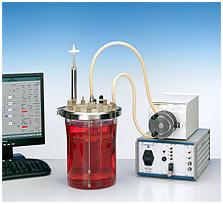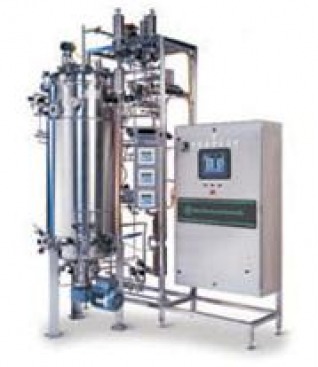Intoroduction To Bioreactors

A bioreactoroperates to rapidly transform and degrade organic waste. The increase in waste degradation and stabilization is accomplished through the addition of liquid and air to enhance microbial processes. This bioreactor concept differs from the traditional "dry tomb" municipal landfill approach.
A bioreactor landfill is not just a single design and will correspond to the operational process invoked. There are three different general types of bioreactor landfill configurations:
Aerobic - Leachate is removed from the bottom layer, piped to liquids storage tanks, and recirculated into the landfill in a controlled manner. Air is injected into the waste mass, using vertical or horizontal wells, to promote aerobic activity and accelerate waste stabilization.Anaerobic - Moisture is added to the waste mass in the form of recirculated leachate and other sources to obtain optimal moisture levels. Biodegradation occurs in the absence of oxygen (anaerobically) and produces landfill gas. Landfill gas, primarily methane, can be captured to minimize greenhouse gas emissions and for energy projects.Hybrid (Aerobic-Anaerobic) - The hybrid bioreactor landfill accelerates waste degradation by employing a sequential aerobic-anaerobic treatment to rapidly degrade organics in the upper sections of the landfill and collect gas from lower sections. Operation as a hybrid results in an earlier onset of methanogenesis compared to aerobic landfills.
The Solid Waste Association of North America (SWANA) has defined a bioreactor landfill as "any permitted Subtitle D landfill or landfill cell where liquid or air is injected in a controlled fashion into the waste mass in order to accelerate or enhance biostabilization of the waste." The U.S. EPA is currently collecting information on the advantages and disadvantages of bioreactor landfills through case studies of existing landfills and additional data so that EPA can identify specific bioreactor standards or recommend operating parameters.
Features Unique to Bioreactor
The bioreactor accelerates the decomposition and stabilization of waste. At a minimum, leachate is injected into the bioreactor to stimulate the natural biodegradation process. Bioreactors often need other liquids such as stormwater, wastewater, and wastewater treatment plant sludges to supplement leachate to enhance the microbiological process by purposeful control of the moisture content and differs from a landfill that simple recirculates leachate for liquids management. Landfills that simply recirculate leachate may not necessarily operate as optimized bioreactors.
Moisture content is the single most important factor that promotes the accelerated decomposition. The bioreactor technology relies on maintaining optimal moisture content near field capacity (approximately 35 to 65%) and adds liquids when it is necessary to maintain that percentage. The moisture content, combined with the biological action of naturally occurring microbes decomposes the waste. The microbes can be either aerobic or anaerobic. A side effect of the bioreactor is that it produces landfill gas (LFG) such as methane in an anaerobic unit at an earlier stage in the landfill’s life and at an overall much higher rate of generation than traditional landfills.
Special Considerations of Bioreactor Landfills
Several considerations about bioreactor landfills must be examined and understood before the EPA can identify specific bioreactor standards or recommend operating parameters. Bioreactor landfills generally are engineered systems that have higher initial capital costs and require additional monitoring and control during their operating life, but are expected to involve less monitoring over the duration of the post-closure period than conventional “dry tomb” landfills. Issues that need to be addressed during both design and operation of a bioreactor landfill include: Increased gas emissions Increased odors Physical instability of waste mass due to increased moisture and density Instability of liner systemsSurface seeps Landfill fires
Universal fomenters
Universal fomenters for use in the laboratory from 50 ml up to 20 L From stirred-, fixed bed-, air lift-, or fluidized bed reactors up to special developments for the constantly growing number of special process technology requirements. Magnetic clutches for absolute sterile and safety axial stirring, with glass conducting pipe for optimal mixture and visual control. Completely automated with remote control and monitoringAutomatic resuspension of foam Low shear-stress to the cellsDirect temperation for short response timesNorm-ports for probes and fittings with low diameter for high occupancy densityUse of heavy duty plastics to reduce weight, non corrosiveDuran glass instead of steel to avoid nickel-release and pittingFor the weight and cost reduction the reactors are produced with flange lid of PEEK than as a simple vesselThe temperature regulation is given by diving probes made of stainless-steel or TitanConvertible and rearm able for every methods by a sterile magnetic clutch OEM-models on enquiry

